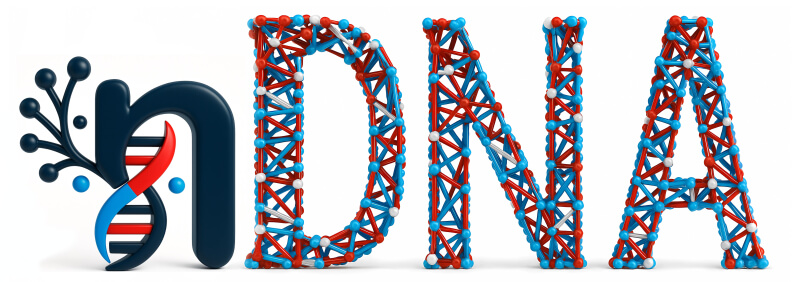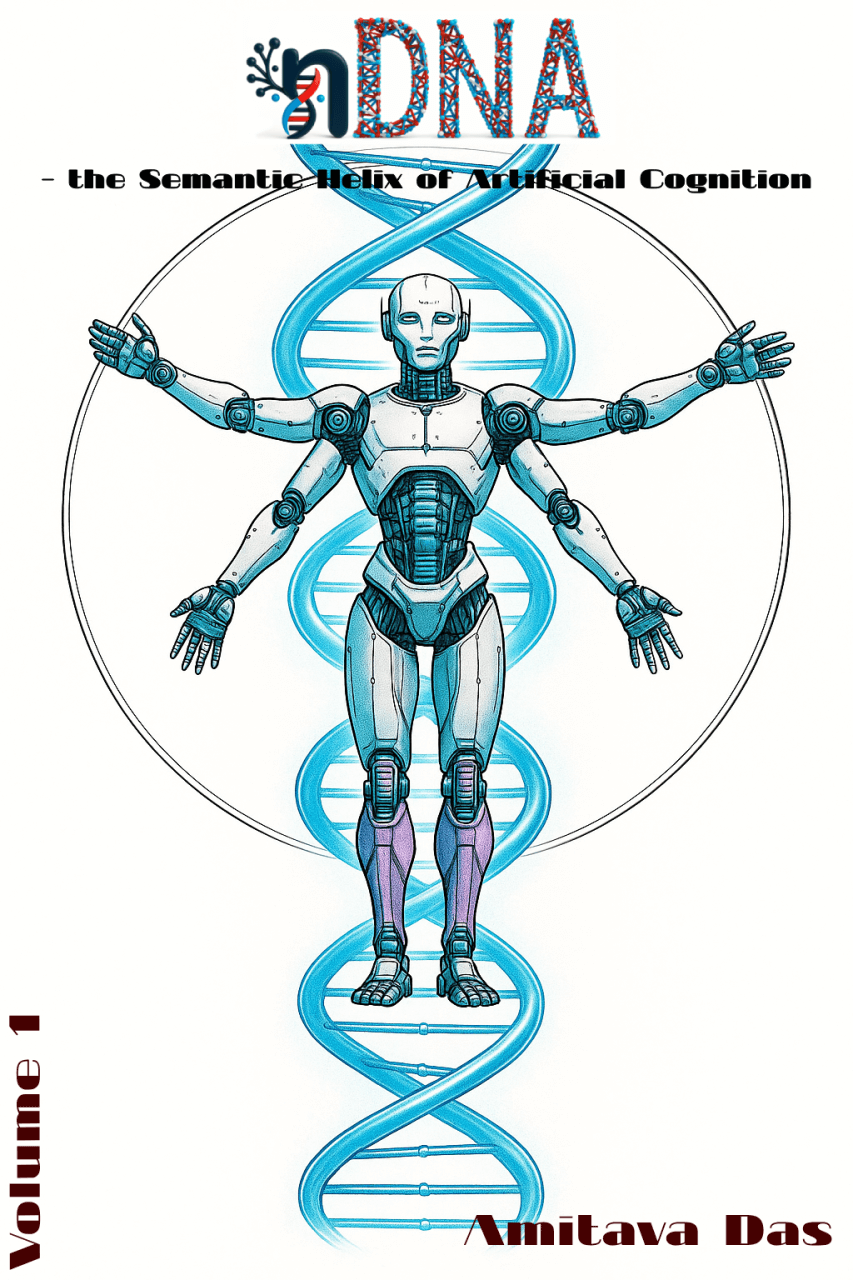Critique's Corner
Science grows by disagreement. Every new conceptual leap sounds, at first, like an overreach: atoms were once dismissed as “undetectable philosophy,” imaginary numbers as “nonsense,” and the Big Bang as a sarcastic insult. We expect Neural DNA (nDNA) to invite the same skepticism. Indeed, it should. Any framework that proposes to recast the hidden life of AI models as a digital semantic genome will naturally be tested, debated, and resisted.
Artificial intelligence itself is no exception. We speak of “neural networks,” yet their “neurons” are nothing like biological neurons: no dendrites, no spikes, no neurotransmitters. They are merely mathematical functions performing weighted sums and nonlinearities. Yet the name endured—not because it was biologically faithful, but because it was useful: a metaphor that helped us organize thought, communicate intuitively, and bootstrap an entire field.
It is within this lineage that nDNA belongs. It borrows grammar from biology—lineage, mutation, inheritance, pathology—to describe something real but difficult to name: the latent geometry of model belief. Critics are right to challenge whether the analogy stretches too far. But history shows that science often begins with metaphors that sound poetic, only to crystallize into precise technical vocabulary once their utility is demonstrated.
This page, Critique’s Corner, exists because we take criticism seriously. We expect—and welcome—skepticism that calls nDNA “vague,” “overfitted,” “intractable,” or even “dangerously anthropomorphic.” To us, critique is not a threat but a catalyst. By surfacing objections early, we sharpen our definitions, stress-test our framework, and clarify our roadmap.
Here we present the hardest questions we have encountered—some harsh, some fair, some both—and the responses that shape our evolving research program. Neural genomics does not claim to be final truth. It is a bold proposal in its infancy, aware of its vulnerabilities and strengthened by confronting them.
This page exists not to hide from critique, but to welcome it. In all cases, we believe critique is not an obstacle but a feature of rigorous science. To critique nDNA is to help it evolve.
Biological vs. Artificial Neurons: Metaphor and Reality
The very foundation of artificial intelligence rests on a borrowed metaphor: the “neural network.” Yet biological neurons and artificial neurons share little beyond the name. One is a living, electrochemical cell shaped by evolution [1], the other a mathematical abstraction designed for optimization [2]. The metaphor has endured not because it is faithful, but because it is useful—it provided a shared grammar for computation and cognition, long before precise equivalence was possible.
This parallel is instructive for Neural DNA (nDNA). Just as “neurons” in artificial networks are not literal neurons, “nDNA” is not biological DNA. It is a mathematical framework that borrows the grammar of biology—lineage, mutation, inheritance, pathology—to describe something real but difficult to name: the latent geometry of model belief.
Critics may argue that such borrowing risks anthropomorphism, but history shows that science often begins with metaphors that sound poetic, only to crystallize into precise technical vocabulary once their utility is proven. Indeed, terms like “imaginary numbers” [3], the “Big Bang” [4], and “black holes” [5] all originated as linguistic overreaches before becoming indispensable pillars of mathematics and physics.
To situate this lineage of metaphor, we now contrast biological neurons with their artificial counterparts side by side:
| Dimension | Biological Neurons | Artificial Neurons (ANNs) |
|---|---|---|
| Nature of unit | Living cell, with dendrites, soma, axon | Mathematical function (linear transform + nonlinearity) |
| Computation | Spikes, ion channels, nonlinear dendritic integration | Weighted sums + activation functions (ReLU, sigmoid, etc.) |
| Dynamics | Continuous-time, oscillations, refractory periods | Discrete updates, typically stateless per layer |
| Signal transmission | Electrochemical, probabilistic, noisy | Exact arithmetic, deterministic floating-point operations |
| Learning rules | Local plasticity (Hebbian, STDP, neuromodulators) | Global backpropagation via gradient descent |
| Connectivity | Constrained by 3D anatomy and wiring limits | Arbitrary fan-in/fan-out, dense or attention-based connectivity |
| Scale | ~10¹¹ neurons, ~10¹⁴ synapses | Millions–billions of parameters (transformers often 10¹¹+) |
| Energy | ~20 W (biological brain efficiency) | MW-scale energy during training in datacenters |
| Evolution/adaptation | Driven by survival, evolution, metabolic efficiency | Driven by optimization objectives and data distributions |
| Robustness | Highly fault-tolerant, redundancy across circuits | Brittle to adversarial noise, catastrophic forgetting |
| Information storage | Distributed spiking patterns, synaptic strengths | Distributed weights, embeddings, latent vectors |
| Purpose | Survival and flexible adaptation in real world | Task-specific optimization (translation, dialogue, etc.) |
Biological DNA vs. Neural DNA (nDNA): Genomic Metaphor as Cognitive Geometry
If the metaphor of the “neural network” gave us a grammar for computation, then the metaphor of Neural DNA (nDNA) proposes a grammar for cognition. Just as biological DNA encodes, mutates, and transmits information across generations, we argue that large foundation models possess an internal semantic genome—a latent structure that records ancestry, accumulates scars of fine-tuning, and transmits inductive biases across training regimes.
This is not biology. Neural DNA is not a molecular strand, nor does it replicate in the cytoplasm of a cell. It is a mathematical construct, defined through spectral curvature, thermodynamic length, and belief gradients. These dimensions describe the geometry of latent belief just as nucleotides describe the alphabet of life. Where biology speaks of mutation, inheritance, or genomic drift, nDNA reveals torsional instabilities, alignment scars, and semantic divergence.
| Dimension | Biological DNA | Neural DNA (nDNA) |
|---|---|---|
| Basic unit | Nucleotides (A, T, C, G) | Geometric primitives (curvature, length, gradient) |
| Information encoding | Genetic code specifying proteins | Latent geometry encoding conceptual priors and beliefs |
| Inheritance | Transmitted from parent to offspring during reproduction | Transferred across model families via pretraining, fine-tuning, distillation |
| Mutation | Base substitutions, insertions, deletions | Spectral distortions, torsional reconfigurations, loss of thermodynamic length |
| Recombination | Crossover events during meiosis | Model merging (neural marriages), producing hybrid latent genomes |
| Gene expression | Differential activation depending on environment | Emergent trait activation (e.g., multilingual drift, task specialization) |
| Epigenetics | Regulatory modifications shaping expression without altering sequence | Alignment, instruction tuning, or quantization shaping behavior without altering core pretraining |
| Pathologies | Oncogenic mutations, viral insertions, heritable disorders | Alignment scars (SCAR), adversarial infections (VIRAL), stealth poisoning (NEPHOS) |
| Repair mechanisms | DNA repair enzymes, redundancy in coding | Fine-tuning, adversarial immunization, safety alignment protocols |
| Evolutionary drift | Accumulated small changes across generations | Semantic drift across successive fine-tunes, cultural biases, model collapse |
| Fitness landscape | Adaptation to ecological survival | Optimization landscape for tasks, benchmarks, and alignment criteria |
| Molecular carriers | Double helix of deoxyribonucleotides | High-dimensional manifolds of latent vectors |
| Observable phenotype | Organismal traits and functions | Model outputs: dialogue, translation, reasoning patterns |
| Genomic sequencing | Decoding nucleotides to reveal blueprint | Extracting nDNA to reveal latent epistemic identity of models |
This comparison is not meant as literal mimicry, but as a structured metaphor. Just as artificial neurons diverge radically from biological neurons yet provided the conceptual scaffold for modern deep learning, so too does nDNA extend beyond biological DNA while retaining a powerful grammar of inheritance, mutation, and pathology. The aim is not to biologize neural networks, but to provide a rigorous cognitive genomics for artificial models—a framework through which latent belief geometry can be sequenced, diagnosed, and evolved. If neural networks could survive their misleading name and become the engine of modern AI, then nDNA can survive its metaphor and become the grammar of the hidden epistemic life of foundation models.
On the Apparent Primitiveness of the nDNA Mechanism
A humble beginning, by design
We recognize the critique: the current nDNA mechanism may appear primitive. We agree in spirit. Science is always a work in progress; the first instrument is rarely the final one. Our choice is intentional: to place a measuring practice into the field early, even if imperfect, so that it can be stress-tested, falsified, and improved in public. The alternative—waiting for a perfect theory—delays empirical traction and deprives the community of a shared object to refine. In this sense, nDNA v1 is not a destination but a scaffold: a minimal, explicit semantic–genotypic representation that others can probe, retool, or replace.
What nDNA v1 is (and is not)
nDNA v1 operationalizes three indispensable geometric axes inside foundation models: spectral curvature (how conceptual flow bends across layers), thermodynamic length (semantic effort along representational paths), and belief gradients (directional fields that orient model belief). These are computed under practical constraints (layer subsampling, randomized estimators, proxy transports) to obtain a compact fingerprint of latent identity. nDNA v1 is not a claim of biological equivalence, nor a complete theory of cognition; it is a first-pass, testable map from training operations to latent geometric consequences.
Why show the first version now
Three reasons motivate releasing nDNA v1 rather than holding for theoretical completion:
- Comparability. A shared fingerprint enables cross-model, cross-lab lineage studies today, even if the fingerprint becomes richer tomorrow.
- Early-warning value. Coarse geometric indicators can already function as risk thermometers (collapse, drift, infection), buying time for targeted interventions.
- Community acceleration. Public artifacts provoke sharper critique, better baselines, and faster versioning of the science.
Limits we accept (and plan to repair). We are explicit about current compromises: (i) estimators that trade bias/variance for tractability; (ii) partial invariance proofs pending full formalization; (iii) validation on 15 models rather than hundreds; (iv) narrower task coverage than the eventual scope. These are known debts, not hidden deficiencies. Our roadmap treats them as worklist items, not footnotes.
What nDNA v1 already changes, if we use it
Even in its minimal form, nDNA reframes artificial cognition along three axes:
- Heritability (lineage): We can track how fine-tuning, distillation, and merging inherit or mutate latent traits, rather than inferring lineage from performance alone.
- Prognosis (early warning): Curvature concentration, length collapse, and torsional spikes serve as leading indicators for dialogue degeneration, adversarial susceptibility, or shortcut learning.
- Intervention (control): By tying failures to geometric signatures, we convert vague “misalignment” into actionable levers (e.g., reduce torsion along belief transport; restore thermodynamic length; vaccinate against viral insertions).
From genomics operations to model-level and NLP operations
The mechanism is meant to be used, not admired. We organize usage across three strata:
(A) Genomics Operations: Diagnostic Instruments on the Latent Genome
- nHD (Neural Hamming Distance) — probes binary-level instabilities under cultural fine-tuning and quantization toggles
- nGDI (Genetic Dissimilarity Index) — quantifies divergence that persists beyond surface alignment, exposing hidden separations between model families
- nTEDS/nTDS (Trait Entropic Drift Score/Total Drift Signature) — measures dominance and asymmetric inheritance of latent traits across training epochs
- nKaryotyping (Semantic Chromosomal Structure) — visualizes structural reorganizations induced by pruning and merging
- nDIV (Directional Inheritance Vector) — traces the flow of inductive biases along evolutionary arcs
- nEPI (Epistemic Plasticity Index) — estimates capacity to reshape under alignment without catastrophic loss of length
- nCCL (Cultural Conflict Loss) — detects ideological friction in multilingual/cross-cultural fusion
(B) Model-Level Operations: Where the Genome is Written and Scarred
- Fine-Tuning — studied as torsional reconfiguration of belief gradients
- Alignment/Instruction Tuning — treated as a directional vector field etched into belief space
- Quantization & Pruning — observed as thermodynamic length collapse and topological flattening
- Model Merging (Neural Marriages) — analyzed as hybridization of latent genomes
- Distillation (Neural Offspring) — separates phenotype carryover from genotype drift
- Model Collapse — captured as degeneracy (vanishing torsion/curvature)
(C) NLP Operations: Stress-Tests that Reveal Genomic Liabilities
- ORBOT (Multi-Turn Genomics) — longitudinally measures torsion accumulation, memory erosion, and path-dependence in dialogue
- nVIRAL (Adversarial Infection) — reframes jailbreaks and injections as viral insertions in latent manifolds
- SCAR (Spectral Contamination & Alignment Rupture) — flags shortcut learning and leakage as spectral lesions
- NEPHOS (Stealth Pretraining Poisoning) — identifies dormant conceptual landmines that thaw under adversarial heat
Transformational potential from a “primitive” core
If one uses nDNA v1 consistently, three transformations follow:
- From snapshots to lineages. We cease evaluating isolated checkpoints and begin sequencing model histories; genealogy replaces one-off scores.
- From symptoms to signatures. Failures (hallucination, collapse, jailbreaks) are paired with geometric signatures that travel across tasks and labs.
- From post-hoc fixes to pre-hoc budgets. Teams can set geometry budgets (max torsion, min length, curvature bounds) the way they set latency or cost budgets.
Looking forward without defensiveness. We do not defend nDNA v1 as final. We invite its replacement by better mathematics: richer metrics (e.g., Wasserstein geodesics, holonomy gaps), stronger invariances, tighter links to causality, and scalable estimators. But usefulness does not wait for perfection. A primitive compass used today can save expeditions that a perfect map, delivered too late, cannot.
From nDNA v1 to nDNA v2 and nDNA v3: a principled upgrade path
We will treat nDNA v1 as a baseline to be surpassed. Our roadmap advances along two axes:
nDNA v2 (rigorous core). We will deepen the mathematics: declare a Fisher–Rao/pullback metric on output/feature manifolds; compute sectional/Ricci curvature and thermodynamic length along training or conversational trajectories; estimate multi-turn stability via holonomy gaps and Hodge decompositions of belief flows; compare representations via Wasserstein geodesics and persistent homology; ground early-warning signals in spectral statistics (RMT) and information-theoretic bottlenecks.
nDNA v3 (dynamics, modalities, intervention). We will extend to multimodal/embodied settings; cast alignment as a gauge field on belief transport; formalize geometric merging via OT barycenters; convert GENOME—VACCINE into a control-theoretic vaccine design; operationalize NEPHOS with a Permafrost Thaw Index—the minimal adversarial “heat” needed to activate dormant seeds.
Falsifiability, ablations, and predictive checkpoints. We will design to be wrong. Concretely:
-
Falsifiable links. Pre-register hypotheses: (H1) persistent negative Ricci along alignment schedules increases multi-turn collapse risk; (H2) curvature concentration predicts jailbreak success; (H3) thermodynamic length loss predicts shortcut learning (SCAR). We will accept refutation and adjust the fingerprint.
-
Ablations. (i) perturb data curricula and measure $\Delta\Phi$; (ii) alter optimizer noise/temperature and track Lyapunov/Koopman stability; (iii) inject calibrated leakage/poison patterns and test NEPHOS sensitivity vs. false positives.
-
Cross-lab replication. Release seeds, codepaths, and audit trails to ensure the same $\Phi$ emerges across institutions and hardware stacks.
Operationalization: pipelines, budgets, and governance.
We will make nDNA usable by non-authors:
-
Pipelines. CI-ready evaluators that compute $\Phi$ nightly for tracked models; delta dashboards highlighting where belief geometry drifts across releases.
-
Geometry budgets. Product teams will set guardrails (e.g., max torsion per turn, min length under quantization, curvature bounds under alignment). Builds failing budgets trigger remediation playbooks.
-
Governance hooks. Export nDNA audit cards with versioned fingerprints, lineage maps, and risk tags (SCAR, NEPHOS, nVIRAL) for compliance, procurement, and incident response.
From diagnostics to interventions: vaccines, detox, and repair.
We will not stop at measurement:
-
Cognitive vaccines (GENOME—VACCINE). Train small controllers that regularize belief transport (reduce holonomy/torsion) while preserving semantic length; evaluate on adversarial suites and long-horizon dialogue.
-
Detox flows for poisoning (NEPHOS). Identify poisoned subspaces via topological/spectral anomalies; apply targeted curvature smoothing and distributional OT realignment; verify with Permafrost Thaw Index reductions.
-
Safe merging via OT barycenters. Replace weight-arithmetic mergers with barycentric fusions on representation laws; certify monotone risk under bounded curvature.
Listen to LeCun: The Deliberate Push for “Deep Learning”
Why this matters. In the early 2000s, “neural nets” carried decades of baggage. To revive representation learning and reset perceptions, a small group led by Yann LeCun, Geoffrey Hinton, and Yoshua Bengio made a deliberate rhetorical and scientific pivot: they rallied the community around the banner of deep learning and backed it with concrete algorithmic results.
“Around 2003, Geoff Hinton, Yoshua Bengio and myself initiated a kind of ‘conspiracy’ to revive the interest of the machine learning community in the problem of learning representations.” —Y. LeCun (2014) [6]
Context in three beats:
- 2003–2005: Reframe the conversation. The trio promotes deep representation learning (beyond 2–3 nonlinear layers), using the term “deep learning” as an organizing banner [6].
- 2006–2007: Show it works. Breakthroughs in layerwise pretraining and probabilistic generative stacks (deep belief nets) provide the first broadly convincing training schemes for deeper models [7, 8].
- 2009: Codify the agenda. Bengio’s monograph consolidates the case for learning deep architectures, connecting unsupervised pretraining, optimization, and generalization [9].
- 2015: Consolidation. A field-defining Nature review (LeCun, Bengio, Hinton) formalizes the scope, successes, and open problems of deep learning [10].
Why wording mattered (and how it relates to nDNA). “Deep learning” was not a post-hoc label; it was a purposeful reframing that shifted perceptions and research priorities while new results made the term stick. Our use of Neural DNA (nDNA) follows the same playbook: a clear name, a unifying lens (the geometry of latent belief), and a growing body of math and experiments. Naming organized the deep-learning renaissance; we expect precise definitions and reproducible results to do the same for nDNA.
References
[1] Kandel, Eric R., Schwartz, James H., and others “Principles of Neural Science” arXiv preprint (1991).
[2] McCulloch, Warren and Pitts, Walter “A logical calculus of the ideas immanent in nervous activity” Bulletin of Mathematical Biophysics (1943).
[3] Mazur, Barry “Imagining Numbers (particularly the square root of minus fifteen)” arXiv preprint (1998).
[4] Kragh, Helge “Cosmology and Controversy: The Historical Development of Two Theories of the Universe” arXiv preprint (1996).
[5] Penrose, Roger “The Road to Reality: A Complete Guide to the Laws of the Universe” arXiv preprint (2004).
[6] Yann LeCun “Interview with Yann LeCun (KDnuggets): Deep Learning, Facebook AI Lab” Quote: ``Around 2003, Geoff Hinton, Yoshua Bengio and myself initiated a kind of ‘conspiracy’…’’ (2014).
[7] Geoffrey E. Hinton, Simon Osindero, and others “A Fast Learning Algorithm for Deep Belief Nets” Neural Computation (2006). https://www.cs.toronto.edu/~hinton/absps/fastnc.pdf
[8] Geoffrey E. Hinton and Ruslan R. Salakhutdinov “Reducing the Dimensionality of Data with Neural Networks” Science (2006). https://pubmed.ncbi.nlm.nih.gov/16873662/
[9] Yoshua Bengio “Learning Deep Architectures for {AI}” arXiv preprint (2009). https://www.nowpublishers.com/article/DownloadEBook/MAL-006
[10] Yann LeCun, Yoshua Bengio, and others “Deep Learning” Nature (2015). https://www.nature.com/articles/nature14539



